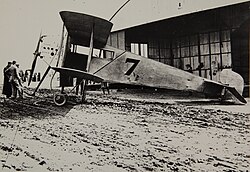Avro Type G
| Avro Type G | |
|---|---|

|
|
| Type: | Multipurpose aircraft |
| Design country: | |
| Manufacturer: | |
| First flight: |
August 7, 1912 |
| Number of pieces: |
1 |
In the Avro Type G is a two-seat biplane - airplane of the British manufacturer Avro .
General
In order to take part in a competition for military aircraft in August 1912, a machine with a closed cabin was designed at Avro. The experiences that had been made with the Type F shortly before were incorporated .
Therefore, the fuselage was very similar to that of the Type F , but this time it was decided to build a biplane instead of a monoplane, making the Type G machine the first closed biplane in the world. In contrast to the type F radial engine, the machine used a narrow in-line engine built into the fuselage. The engine was cooled by two external radiators .
The wings, tail section and landing gear were identical to the parts already used on the Avro 500 . The steel-clad rudder was designed so that it also acted as a stern skid.
Avro originally intended to enter the competition with two aircraft. The starting number 6 was equipped with a Green in-line engine, the starting number 7 was to be equipped with an ABC engine.
Since the ABC engine was not completed in time, the starting number 7 was also equipped with the Green engine. The intended pilot was Wilfried Parke, who had already flown the Type F.
The machine wasn't finished until just before the competition, and there was no time for a test flight. The plane was brought to the Larkhill venue in a box and first flown from Parke on August 7, 1912.
A three-hour reliability flight was planned, but due to strong winds Parke broke off after 30 minutes. Due to an unforeseen downdraft on the approach, the machine overturned and was badly damaged.
Within a week it was repaired with parts of the other Type G and brought back to the venue - shortly afterwards Parke demonstrated the good properties of the machine on flights in heavy rain and strong winds.
Avro received an award for the Type G in Larkhill because the machine had passed all required test flights. The time it took to assemble the machine was particularly impressive. The aircraft was complete in 14.5 minutes; In contrast, it took Farman's crew almost 9.5 hours to assemble their biplane.
For the special price offered at the comparison competition in Larkhill, however, the Type G was not enough due to its poor climbing performance.
On October 22, 1912, works pilot FP Raynham took part in the “British Empire Michelin” reliability race, but had to cancel the flight after 3.5 hours due to a broken cooling water pipe.
Two days later, Raynham set a new record in endurance flight for British aircraft with 7 hours and 31 minutes before he had to land due to a lack of oil. However, this record only lasted about an hour, because Harry Hawker , who had started simultaneously with a Sopwith-Wright, stayed in the air for 8 hours and 23 minutes.
After this event, the only ever airworthy Type G was flown to Avro's home airfield in Shoreham; She was last seen there in February 1913 in the hangar.
Technical specifications
| Avro Type G | |
| Parameter | Data |
|---|---|
| length | 8.68 m |
| height | 2.97 m |
| Wingspan | 10.74 m |
| Wing area | 31.13 m² |
| drive | a Green in-line engine with 44.74 kW (60.83 PS) |
| Top speed | approx. 100 km / h |
| Rate of climb | approx. 32 m / min |
| Range | approx. 555 km |
| crew | 1 pilot, 1 passenger |
| Empty weight | approx. 540 kg |
| Max. Takeoff mass | approx. 813 kg |
See also
literature
- AERO issue 16, p. 448
- Michael JH Taylor: Jane's Encyclopedia of Aviation. Studio Editions, London 1989, p. 91.
- World Aircraft Information Files. File 889 Sheet 93, Bright Star Publishing, London.